 REVIEWED THIS WEEK:
REVIEWED THIS WEEK:
– Silent Dragon #1
– The Defenders #1
– Dungeons & Dragons: Homeworld #1 & 2
– The Middleman #1
– Zombie King #0
– Mutation #1
– All Star Batman & Robin #1
– JSA Classified #1
– Heartbreak #1
– Tales Designed To Thrizzle #1
First Look: Diggle and Yu Crow About Cyberpunk Samurai in “Silent Dragon”
By Russell Paulette
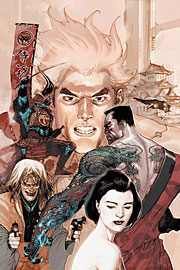 Cross-pollinating genres seems to be a formula that, by-and-large, works really well in the American comics market. Pure speculation leads me to believe that the success of the super hero in the Twentieth Century might have had a lot to do with this. Since the super-hero is a hybrid of a couple different pulp genres, it follows that the next gestalt in our market might just be taking two or three different elements and making a stew out of them. Of course, the converse explanation to all of this is that the formula works because, well, putting different toys together is just freaking rad.
Cross-pollinating genres seems to be a formula that, by-and-large, works really well in the American comics market. Pure speculation leads me to believe that the success of the super hero in the Twentieth Century might have had a lot to do with this. Since the super-hero is a hybrid of a couple different pulp genres, it follows that the next gestalt in our market might just be taking two or three different elements and making a stew out of them. Of course, the converse explanation to all of this is that the formula works because, well, putting different toys together is just freaking rad.
I mean, who doesn’t want to see dinosaurs with machine guns, time-traveling monkeys or zombie/vampire/whatever/pirates? Or, in the case of Andy Diggle and Leinil Francis Yu’s Silent Dragon, a world filled with sci-fi samurai.
In the first issue of this six-issue mini-series, Diggle introduces us to
Playing like an Akira Kurosawa movie scripted by William Gibson, Diggle’s story is intriguing without being overly preachy or thinly political. There’s a clear tension between traditionalist values versus modern, technological ones, and Renjiro seems to be our avatar through both worlds. Added to that, he deftly hits the standard themes one would expect from such an eastern tale—honor, loyalty, betrayal, revenge—and does so in such a way that is both expected and refreshing. It’s not a great story or script, but it is a good one, and Diggle’s a smart enough writer that he steps out of the way and just lets the story and the artist do their respective jobs.
And on the artistic front, Yu churns out some impressively rendered spectacle here, as he portrays the promised bombast of some of the action with verve and class. His storytelling is sharp, and always with an eye towards smart page design that leads the eye cleanly through the scenes while still keeping the arrangements and layouts interesting. His character work is distinctive, and his designs—particularly on some of the more fantastic elements of the book—a delight. The near full-page spread of the samurai-robot alone is worth the price of admission.
Overall, it’s a promising start to what looks to be a fun series. I’m not sure that the sci-fi / samurai combo is necessarily inspired, but it is entertaining and a solid enough approach to an interesting new world.
THREE AND A HALF OUT OF FIVE VIKINGS

I Can’t Believe It’s Not Justice League… NO! It’s “The Defenders”!
By Graig
 Kieth Giffen, J.M. DeMattis and Kevin Maguire each have their own (mostly) respectable separate careers in comics, with some solid and diverse output. But as the years have passed since they teamed up to recreate the Justice League in 1986 out of second-stringers and “whozzat?” characters, turning out the first monthly superhero situation comedy, they’ve achieved an almost legendary status (imagine the stones it took creating a funny funnybook during the heyday of The Dark Knight Returns and The Watchmen). So when they get together it’s like the Beatles reuniting, which they never did, so that’s a bad analogy. Okay, it’s like the Pixies reuniting, and finding out that, man, they still got it. They still work as that finely oiled team I remember them being almost 15 years ago.
Kieth Giffen, J.M. DeMattis and Kevin Maguire each have their own (mostly) respectable separate careers in comics, with some solid and diverse output. But as the years have passed since they teamed up to recreate the Justice League in 1986 out of second-stringers and “whozzat?” characters, turning out the first monthly superhero situation comedy, they’ve achieved an almost legendary status (imagine the stones it took creating a funny funnybook during the heyday of The Dark Knight Returns and The Watchmen). So when they get together it’s like the Beatles reuniting, which they never did, so that’s a bad analogy. Okay, it’s like the Pixies reuniting, and finding out that, man, they still got it. They still work as that finely oiled team I remember them being almost 15 years ago.
But what’s this? That’s not the DC Bullet in the corner of the cover, it’s not even the new toilet-bowl cleaner-esque swirl they call an emblem these days. It’s (SHOCK) Marvel, and that “Defenders” logo looks nothing like “Justice League”… the letters are all different. Perhaps if I squint Dr. Strange might look like Mr. Miracle, and Silver Surfer like Blue Beetle, and the Hulk like Guy Gardner, and Namor like Oberon. No, it’s no use. This isn’t the Justice League, but it is Giffen, DeMattis and Maguire, and, well, it’s good. Damn good.
The five issue mini-series begins with the nefarious Nightmare possessing Dr. Strange’s manservant Wong (“When he finds out you’re still calling him your ‘man-servant’ – he’s really gonna be ticked”, Nightmare quips) to alert him of a plot by the siblings “the dread Dormammu and Umar the unholy” to invade Earth, taking over our dominion and enslaving all of humanity (in an implied Bush-ian fashion). Naturally, Strange is going to have to assemble a team… well not just any team, the Defenders. The problem is, none of these guys get along. Bruce Banner has to be guilted into joining, while Strange must stroke Namor’s ego to have him tag along. The Silver Surfer, well, he’s found himself a commune and he’s happy in his ignorance of anything beyond the waves. In typical Giffen / DeMattis fashion, this ungainly team has the fate of the world in their hands, and you can bet saving it isn’t going to be easy.
I’ve never been a big Marvel reader, so aside from the key heroes, the names I mentioned here have no history for me, and the great thing about this Defenders book is it doesn’t matter. You understand the threat easily, you get what the characters’ powers are, you understand the dynamics of their relationships immediately, and all the while the dialogue is infused with the Buffy-esque witty repartee that just avoids being out of character.
Maguire’s art is inspired. He is undoubtedly the master of expression in comic books. There isn’t an emotion or facial expression he can’t draw, and when you’re drawing twenty-four pages of primarily talking heads, you need to have range. Hell, half the actors in
This is some of the most fun you’ll have in comics this year. Like purple is the new black and Boston Terriers are the new Pugs, the Defenders are the new Justice League, and despite myself, I’m damn happy for it.
FIVE OUT OF FIVE VIKINGS

Forgotten Realms “Homeland” Has Plenty Of Dungeons Without All Those Annoying Dragons
By Rob Glenn
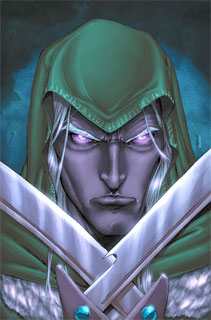 The Wizards of the Coast company has a great franchise on their hands. I remember the first time I played “Dungeons & Dragons”. Partway through my initial adventure I got enough experience points to go up a level and much to the chagrin of my Dungeon Master, I stopped the game dead to work out the math. I wanted more hit points and I wanted them right then. It’s a fantastic game that unfortunately takes too much time and at least one other geek friend to play. Things that I am personally lacking. For those who are sorrowed by the finality of the Lord of the Rings universe, the D & D world is as infinite as you want. Unlike
The Wizards of the Coast company has a great franchise on their hands. I remember the first time I played “Dungeons & Dragons”. Partway through my initial adventure I got enough experience points to go up a level and much to the chagrin of my Dungeon Master, I stopped the game dead to work out the math. I wanted more hit points and I wanted them right then. It’s a fantastic game that unfortunately takes too much time and at least one other geek friend to play. Things that I am personally lacking. For those who are sorrowed by the finality of the Lord of the Rings universe, the D & D world is as infinite as you want. Unlike
Fortunately, there is the extremely large number of paperback books under the headings of “Dragonlance” and “Forgotten Realms”. Hundreds of books that all fit in your back pocket just waiting for a break between classes or a ride on the bus to give you a quick dose of the medieval. It’s only a logical extension of these to go the way of the graphic novel. It’s a wonder that it took them so long.
The Homeworld miniseries is a “Forgotten Realms” story. Drizzt Do’urden is a Drow apart. A Drow, of course, is more or less an evil elf. They live deep underground shunning the light and the lawful good creatures that live in open space. It is the Drow way to kill one another to gain position in their complicated societal rules. What makes Drizzt different is that he has an ingrained sense of honor and justice. He excels at his melee training, but shuns the literal backstabbing that the Drow believe keeps them strong as a race.
After reading the first of three 40-plus page books I felt like I was experiencing one of the more unpleasant aspects of playing D & D. Whenever you have a big group playing the game this comic is based on, you always have that one guy. We’ll call him Gonzo Van Details. Gonzo is less interested in cracking goblin’s skulls as he is making up infinitesimal minutiae about his character: what color his eyes are, what’s his favorite brand of mead, that he has a scar on his left eyebrow; things that may be fun for him to dream up but are increasingly annoying to everyone else. The first book in this series is Gonzo’s character’s backstory.
If you hang around for Homeworld # 2, you will be surprised. R.A. Salvatore (who is a veteran of the “Forgotten Realms” literature) crafts a story that sneaks up on you. We have elves and giant scary monsters and a dude with a burnt face… and intrigue! I hate to use the word “woven”, but Salvatore has done just that. This is a fully realized, complex story. It goes beyond Gonzo. The art by Tim Seeley is subdued at times. Some of the more violent images happen just to the side of the panel, no doubt to keep this book from having to be sold from the top shelf of the bookstore. He slips a few good ones in, though. I especially liked the giant cat taking a bite out of a Creature from the Black Lagoon’s shoulder. Seeley has a gift for keeping the look of a character consistent, which is lucky for us as the computer coloring on this book is a tad lazy. Yes, it’s necessary for the character’s skin to be that slate-green color, but you can change up the tone here and there. A lighter shade here and a darker one there would be most helpful for the reader. As it stands, you have to stare at some panel looking for visual cues to figure out who’s talking.
Issue #3 of Homeworld will be out in a month. If you miss those old basement days when you’d chase barbeque chips down with Mountain Dew and played a game requiring math skills, I recommend picking up this little series.
THREE AND A HALF OUT OF FIVE VIKINGS

If You Liked “Men in Black” Then You’ll Love “The Middle Man”
By Sean Fahey
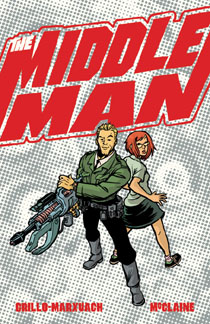 I’ll cut right to the chase. If you enjoyed Men in Black then you are going to love Viper Comics’ new mini-series The Middleman. It’s not a complex book. What you see is what you get. But at the end of the day, its energetic combination of over-the-top zany science fiction and situational comedy translates into a bundle of fun. Nothing wrong with that. Comic books can still just be fun right?
I’ll cut right to the chase. If you enjoyed Men in Black then you are going to love Viper Comics’ new mini-series The Middleman. It’s not a complex book. What you see is what you get. But at the end of the day, its energetic combination of over-the-top zany science fiction and situational comedy translates into a bundle of fun. Nothing wrong with that. Comic books can still just be fun right?
The Middleman # 1 is interesting in the sense that it evokes the pulpish quality of sci-fi’s yesteryear but adds a contemporary sense of humor. The protagonist Wendy Watson reminds me a lot of Jaye Tyler from the hilarious but tragically short-lived show Wonderfalls; an overeducated under-motivated twenty-something wage slave who meets life’s challenges with sarcasm and a quick wit, and has a penchant for stumbling across bizarre situations. And like Jaye, Wendy also manages to have seemingly bad situations turn into blessings in disguise, as a run in with a nuclear-vomit spewing blob costs her one job (I hate when that happens) but lands her another…as a member of a super-secretive group of monster hunters.
The Middleman # 1 is a light read. It’s an introduction and not very plot heavy, but for a book like this it’s the characters that matter anyway – and I dig Wendy. As far as central characters for sci-fi / comedy stories go she’s pretty fresh, and writer Javier Grillo-Marxvach (whose previous writing credits include “Lost”) crafts some funny and clever dialogue for her. In a tip of the hat to fan boys everywhere, there’s also some nice geek humor here as well, with references to “A Clockwork Orange” and X-Box culture.
Visually, the black and white dot-matrix shading scheme definitely gives The Middleman a pulp quality (which is its intended effect), but at times also clutters the panel, causing some of the detail in artist Dean Trippe’s line work to be lost. Otherwise, the artwork here is sharp, an exaggerated cartoonish style, not unlike Bruce Timm’s, that lends itself well to situational comedy where the character’s reaction is half the punch line.
Mutant aliens and sharp tongues…I’ll be sticking around for the duration of the mini-series.
THREE OUT OF FIVE VIKINGS

He Just Had to Go There… Frank Cho Does Zombies
By Graig
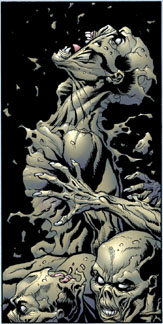 The man can draw. If you’ve seen anything he does, you know this. Frank Cho makes pretty, pretty pictures, and even more so, pretty, pretty women. So then why would Cho want to draw the ugliest thing imaginable? Sure, they are cool, but there’s nothing sexy about zombies, absolutely nothing (unless, perhaps, you are a necrophiliac, at which point you’re sick, and you should stop reading this column and immediately seek help).
The man can draw. If you’ve seen anything he does, you know this. Frank Cho makes pretty, pretty pictures, and even more so, pretty, pretty women. So then why would Cho want to draw the ugliest thing imaginable? Sure, they are cool, but there’s nothing sexy about zombies, absolutely nothing (unless, perhaps, you are a necrophiliac, at which point you’re sick, and you should stop reading this column and immediately seek help).
Perhaps, like Elizabeth Berkley taking her post-Saved By The Bell/”I’m a grownup now” turn in Showgirls, Cho wants to shed his good-girl, cheesecake-drawing image by creating some sick, shocking visuals with Zombie King. Well, he certainly did that, if page three is any indication. For those that haven’t heard the controversy yet, Cho has drawn a zombie schtupping a cow. So shocking and crude is this that Image has allowed the book to be returnable, since most retailers didn’t know that there would be such material in a zombie book, and you know that’s not suitable for minors. I’m surprise it made it across the border.
From there the book features exploding brains, dismembered limbs, dangling entrails and, most shockingly of all, four dull pages of talking head exposition telling us that an experiment went wrong and now this Big Pharma company has created zombies that run on the most primal of urges: sex and food. I knew it would happen eventually, though I always hoped it wouldn’t. I mean the idea of being eaten and/or turned into a zombie is disgusting enough, but now Cho has added rapist and zoophilia to the zombie repertoire. Perhaps I’m a prude, but this is just too much.
Moralistic objections aside, Zombie King # 0 is a weak introduction to Cho’s zombie world. Beyond the shock of the zombie-on-cow action, the book doesn’t really add much to the ever-growing land of zombie stories. Even Cho’s artwork suffers, as there is a distinctive lack of background everywhere in this book. His character renderings are fantastic, as usual, but there’s no scenery, nothing else to look at but the characters. It’s overall a little too thin on story and visuals.
I was looking forward to the title beforehand. I mean anyone who likes zombies and has even passing familiarity with Cho’s work would. But so great is my disappointment that now I can’t even say whether I’ll be back for the first-issue proper.
ONE AND A HALF OUT OF FIVE VIKINGS

New Superhero Series “Mutation” Has Potential…A Lot of Potential
By Sean Fahey
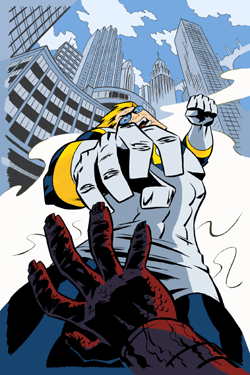 Mutation, the new superhero series from Speakeasy Comics, focuses on some interesting themes. Instead of the typical “With great power comes great responsibility” mission statement that colors most superhero comics, Mutation instead asks “With great power comes….who knows?” The series follows the adventures of Trent Tyson, a student at
Mutation, the new superhero series from Speakeasy Comics, focuses on some interesting themes. Instead of the typical “With great power comes great responsibility” mission statement that colors most superhero comics, Mutation instead asks “With great power comes….who knows?” The series follows the adventures of Trent Tyson, a student at
It’s an intriguing premise and a question I don’t think enough superhero comic books bother to ask. But after reading Mutation # 1, you’d have no idea that this is what the series is about. In fact, the inaugural issue reads much like the conventional superhero book its creators have designed it not to be, with only subtle (but intelligent) visual and narrative clues hinting at
That said, Mutation # 1 is a great looking book. The artwork here alone is enough of a hook for me. Artist Ethen Beavers has a kinetic style and brings a lot of energy to the page. Beavers’ sharp angular line work (reminiscent of Mike Oeming and Darwyn Cooke) allows his mystery men a larger than life – iconic even – appearance. And the colors here are vibrant, literally leaping off the page (Kudos to Jamie Jones). Beavers is also skilled at conveying emotion – which is critical during a key sequence in this issue where
Mutation # 1 is a good start to what I honestly believe will be a very good series.
THREE AND A HALF OUT OF FIVE VIKINGS

Miller and Lee Shoot For Not-Quite-Camp in “All Star Batman and Robin, The Boy Wonder”
By Russell Paulette
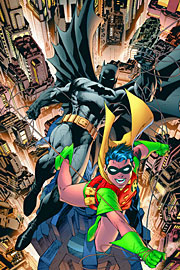 At a week or two since it’s street date, doing a review of the first issue of Frank Miller and Jim Lee’s titanic team-up on All Star Batman & Robin, The Boy Wonder # 1 seems a little late to the party. In that time, it seems everyone’s had a chance to weigh in on the book. However, when you strip away all the hype, all the vociferous reaction, there’s always the final litmus test anything must be judged against: is it any good?
At a week or two since it’s street date, doing a review of the first issue of Frank Miller and Jim Lee’s titanic team-up on All Star Batman & Robin, The Boy Wonder # 1 seems a little late to the party. In that time, it seems everyone’s had a chance to weigh in on the book. However, when you strip away all the hype, all the vociferous reaction, there’s always the final litmus test anything must be judged against: is it any good?
I might be going out on a limb here, but I can honestly say that, you know what? Yeah, it was pretty good.
Wasn’t change-my-life-and-my-underwear good, wasn’t never-need-to-read-another-Batman-comic good. Just good. Clean. Fun.
To catch up everyone arriving late after the previews, the first issue of this new Batman title teams Miller and Lee on a revisionist look at Robin’s origin. As such, it pretty much hits the high-points needed on that front: you got young Dick Grayson as an aerialist in the circus; Batman as a new, curious element in the Gotham skyline; Bruce Wayne as the young socialite all the men want to be, and all the women want to be with; and the Gotham City Police Department, corrupt as all hell.
Miller’s way in for the story is through reporter Vicki Vale who, in what seems a much-contested moment, has a penchant for lounging in her skivvies. She’s prepping a column on the Batman when she gets an unexpected invitation by Bruce Wayne to join him on a date to the circus, and away we go. At the circus, young Dick Grayson displays his acrobatic chops, only to have his moment of glory cut down as bullets whiz past his head to find the foreheads of his both parents. (Another contested moment—apparently, Miller’s version dispenses the baroque tragedy of the goons messing with the acrobat’s rope, and settles on getting the job done expediently.) The rest of the story is a frenzy, as Miller bounces between Batman-in-the-shadows, Dick’s shock at the loss of his parents couple with his shock at his apprehension by the cops, and Vicki’s drafting Alfred into her attempt at the scoop-of-the-century.
Personally, I’ve no problem with Miller’s script whatsoever. The key to his story, though, is economy, as we get introduced to an awful lot of story real-estate in a very short amount of time. Perhaps, as readers familiar with the material, we might short-shrift what Miller’s done in these twenty-odd pages, but to cover as much ground as he does in these pages is, simply, a wonderful thing. And while it’s not Miller’s finest work, it’s certainly fun in a twisted sense of the word—it is Miller, so fun isn’t going to have that same day-glo, Silver Age pop that fans mean when they talk about fun. To a certain degree, though, these pages sing with a perverse glee, and part of that is aided by Miller crafting the piece around Lee’s artwork.
Lee’s one of those artists people seem to love or hate. And, regardless of your opinion of the accuracy of his figures, or the density of his linework, it seems hard to argue the precision of his storytelling. The particulars of any given panel are usually clear and, outside of any other value judgments, that’s a rare gift for an artist—particularly a “hot” artist—to display. His Batman is appropriately creepy and menacing, and his cops are doubly so. Vicki has the appropriate curves and va-va-voom the script requires from the ogling scenes, and his young Dick Grayson shows a fantastic sense of grace and fluidity. It’s easy to see why, on a superficial level, he’s a fan-favorite artist, but looking closer, you can see why he’s a bit more respected. As a flashy, super-hero artist, you honestly can’t do much better.
Honestly, I’m not quite sure what all the uproar is about. We’re getting the Dick Grayson origin from a point-of-view that seems, distinctly, to be centered on the mystery and wonder of a twelve-year-old boy. On top of that, we’re getting a book done by two A-game creators bringing the sum total of their abilities to bear on what is, in essence, a fun comic. Is it dark? Sure. Is it moody? It’s Batman, what do you expect? Is it a bit arch, and a bit melodramatic and over-the-top? Take a look at the marquee. It’s got “The Boy Wonder” at the end of the title, for Odin’s sake. It’s just good fun.
FOUR OUT OF FIVE VIKINGS

“JSA Classified” Details the Origins of Power Girl
By
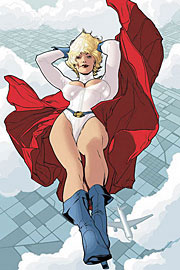 Rocketed to Earth as a teenager, Power Girl seemed tailor-made to believe she could be Superman’s cousin. She could fly at super-speeds, possessed invulnerability, and adopted a similarly evocative codename. The Justice League accepted her. The Justice Society gave her a life and new name, Karen Starr. More importantly, Superman accepted her. She had all she’d ever wanted and then…The Batman. The World’s Greatest Detective found her story to be a lie. As much as she and everyone wanted to believe, she wasn’t Kryptonian and this would be the first of many heartbreaks for this young hero. She’d later come to believe she’d found her heritage in Atlantis only to find out that that to was a lie. She pretty much let Karen Starr die, choosing to become Power Girl full-time, bouncing about The DC Universe looking for someplace to belong. She joined Justice League:
Rocketed to Earth as a teenager, Power Girl seemed tailor-made to believe she could be Superman’s cousin. She could fly at super-speeds, possessed invulnerability, and adopted a similarly evocative codename. The Justice League accepted her. The Justice Society gave her a life and new name, Karen Starr. More importantly, Superman accepted her. She had all she’d ever wanted and then…The Batman. The World’s Greatest Detective found her story to be a lie. As much as she and everyone wanted to believe, she wasn’t Kryptonian and this would be the first of many heartbreaks for this young hero. She’d later come to believe she’d found her heritage in Atlantis only to find out that that to was a lie. She pretty much let Karen Starr die, choosing to become Power Girl full-time, bouncing about The DC Universe looking for someplace to belong. She joined Justice League:
Lately, Power Girl’s been exhibiting powers akin to Superman’s. When exposed to Kryptonite, she suddenly weakens. When possessed by a threat, her eyes glow red, suddenly filling with heat. But just as quickly as it comes, it goes. It’s up to the JSA’s resident medico Dr. Mid-Nite to help Karen Starr finally find out once and for all just “Who is Power Girl?” The clues point to the improbable and the mystery beginning within the pages of JSA: Classified #1, on sale now.
After fixing Hawkman and then Green Lantern for DC Comics, if anyone were manor-born to take on the broken “origins” of Power Girl, it’s writer Geoff Johns. Johns smartly unravels the mystery by simply laying out everything we know, and what we see is a character desperate to belong. For the first time, after reading her adventures for over twenty years, Johns made me “get” this character. Power Girl has become an incredible mix of brass and sorrow under Johns, who portrays her as more than just an attitude in a costume.
Artist Amanda Conner’s “cartoonish” style, honestly, wouldn’t have been my first choice for this particular arc of JSA: Classified. But upon opening its’ first page, all doubt rapidly faded. Conner is perfect here. She supplies this story with a big, open style perfect for a big and open character like Power Girl. Conner is the first artist I’ve seen invest this character with notable expressions and gestures that convey something other than annoyance. Conner’s Power Girl easily goes between smiles, confusion and tears, perfectly enhancing the intent of Johns’ scripting. Conner understands the job of penciller very well.
With DC breaking their necks lately to introduce a new Supergirl, (There’s been like four in the past couple of years) it’s good to see DC has deciding to re-invest in one of their more fascinating and beautiful of creations. I’m adding this one to my pull-list.
THREE AND A HALF OUT OF FIVE VIKINGS

“Heartbreak” stirs up some buried memories
By Graig
 The amount of fine looking women walking downtown
The amount of fine looking women walking downtown
When I approached the stop I saw this lovely semi-gothic woman wearing a full-length crush velvet black dress with some black platform shoes. She had shoulder length raven hair and dark mascara around her cat-like eyes. I was smitten immediately and I tried not to stare, but I knew I couldn’t even dare approach her. How scummy is it to try and pick up a lady on the transit system? I would steal glances as I stared down the street looking for the streetcar, my mind racing a mile a minute, no solid thoughts forming. As the transit approached I was distracted for a second as a girl in a backpack brushed past me, stepped from the curb and was sideswiped by a speeding car who failed to yield to the streetcar’s stop signal. The girl hit by the car careened back towards the sidewalk where the semi-Goth and I rushed to her aide. We spent a good 20 minutes with her before the ambulance came and took her away, and we spent a few more minutes chatting while we waited for a police officer to take our statement. We found out a little bit about each other and we were casting smiles back and forth like a tennis match.
We took the next streetcar and sat together with a little bit of “getting to know you” chit-chat. She told me where she worked, and I knew the place, and before getting off the transit, she said I should stop by sometime. For days I agonized whether she really meant it and whether I should actually do it, and I got myself incredibly worked up about it. I mean, this girl was all kinds of sexy and I wasn’t sure I was ready for that. But I bolstered my esteem, and five days after our meet-cute I went to her work, a massive 3-floor music and video store. I strolled the entire place with a nervous “casual” demeanor, twice, before finally spotting her at the top of a flight of stairs. I paused, and my heart went spastic to the point that if I opened my mouth I could hear it pounding in stereo. I approached, she smiled, and out of my mouth spewed forth some gibberish even I didn’t understand. “I’m sorry,” I apologized, “I left my brain in the basement.”
It wasn’t all lost; she let me accompany her on some errands before we hit the transit home. She didn’t outwardly reject my proposal for drinks, but she couldn’t accept it either with her parents visiting. I always had this idea of giving girls my number instead of asking them for theirs (here’s a tip: this is a stupid idea) and I waited patiently for weeks for her to call. For a month, every time the phone would ring, I would jump. I would glance around the streetcar every day on my way home to see if she was around. I even went back to the store once or twice but she was never there. That was my first heartbreak in the big city.
Heartbreak, an anthology series by co-creators Nick DeStefano and Jonathan Rivera, is full of painfully awkward and endlessly relatable true-life tales such as this. If you’re familiar with insecurity or awkwardness, if you’re hardly a Lothario, if your success with the ladies is mixed at best, then you can take comfort in Hearbreak, for you are not alone. Brutally honest, but with awareness of the humor in pain, DeStefano and Rivera each tell their stories with natural ease, the truth in their tales resonating much stronger than fiction ever could. DeStefano’s style is open cartooning, with simplistic (but effective) characters and little shading, like if Humberto Ramos did romance-gone-wrong. Rivera’s art reminds me of to Becky Cloonan or Paul Pope, with a sketched feel and gray washes to accentuate mood and detail. Both are very capable storytellers with distinctive voices, and the three issues (so far) will not just entertain, but likely drag up some (insert your own adjective here) memories.
(Heartbreak can be purchased on-line at www.heartbreakcomics.com or through www.midtowncomics.com)